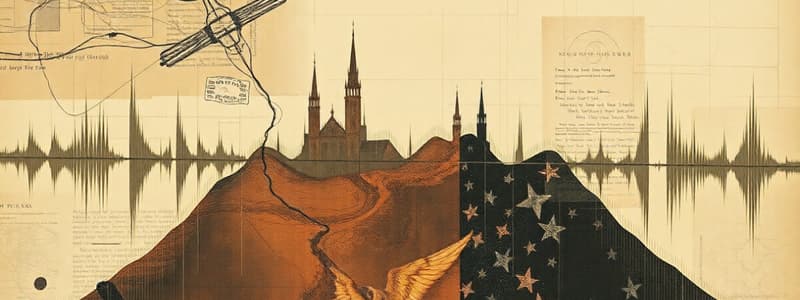Podcast
Questions and Answers
An SSBSC signal loses both the carrier and one sideband compared to a standard AM signal.
An SSBSC signal loses both the carrier and one sideband compared to a standard AM signal.
False (B)
A DSBSC has a missing carrier when compared to a standard AM signal.
A DSBSC has a missing carrier when compared to a standard AM signal.
True (A)
For undistorted AM to occur, the modulating signal voltage Vm must be less than the carrier voltage Vc.
For undistorted AM to occur, the modulating signal voltage Vm must be less than the carrier voltage Vc.
True (A)
When the modulation index m is less than 1, overmodulation occurs in the AM signal.
When the modulation index m is less than 1, overmodulation occurs in the AM signal.
An SSBSC signal retains both the carrier and one sideband compared to a DSBSC signal.
An SSBSC signal retains both the carrier and one sideband compared to a DSBSC signal.
An SSBSC signal contains both the carrier and one sideband compared to a standard AM signal.
An SSBSC signal contains both the carrier and one sideband compared to a standard AM signal.
In a DSBSC signal, the carrier is present while one sideband is missing.
In a DSBSC signal, the carrier is present while one sideband is missing.
For undistorted AM, the modulating signal voltage Vm can equal the carrier voltage Vc.
For undistorted AM, the modulating signal voltage Vm can equal the carrier voltage Vc.
Overmodulation occurs in the AM signal when the modulation index m is greater than 1.
Overmodulation occurs in the AM signal when the modulation index m is greater than 1.
The characteristics of a DSBSC signal include an intact carrier and two sidebands.
The characteristics of a DSBSC signal include an intact carrier and two sidebands.
Flashcards are hidden until you start studying
Study Notes
Amplitude Modulation (AM)
- Single Sideband Suppressed Carrier (SSBSC) signals are a type of amplitude modulation (AM) where the carrier signal and one sideband are removed, leaving only one sideband. This results in more efficient use of bandwidth.
- Double Sideband Suppressed Carrier (DSBSC) is another type of AM where only the carrier signal is removed, leaving both sidebands intact.
- Undistorted AM requires that the modulating signal voltage (Vm) must not exceed the carrier voltage (Vc).
- Overmodulation occurs when the modulation index (m) is greater than 1. This results in distortion of the AM signal, affecting the quality of the transmitted information.
Single Sideband Suppressed Carrier (SSBSC)
- SSBSC signals are a type of Amplitude Modulation (AM) signal that has had the carrier and one sideband removed.
Double Sideband Suppressed Carrier (DSBSC)
- DSBSC signals are a type of Amplitude Modulation (AM) signal that has had the carrier removed.
Amplitude Modulation (AM)
- Unmodulated AM signals require a modulating signal voltage (Vm) to be less than the carrier voltage (Vc) to prevent distortion.
- When the modulation index (m) exceeds 1, overmodulation occurs in the AM signal.
Studying That Suits You
Use AI to generate personalized quizzes and flashcards to suit your learning preferences.




